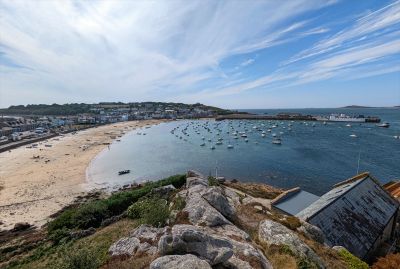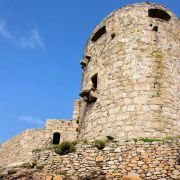
Hugh Town is the de facto capital of the Scilly Isles. Located on St Mary's this charming little town is where the majority of visitors to the islands will spend the majority of their time.
Whether Hugh Town is actually a town or village is up for debate. With a population of just over a thousand it certainly isn't big, but it does have something of a bustle to it and the high street (Hugh Street) is surprisingly elegant. Lined with an eclectic mix of granite buildings you find a number of pubs, shops, cafes and restaurants as well as a Post Office and supermarket. Until relatively recently there were also two banks and a newsagent selling the daily paper which was shipped over every morning.
One thing that surprises a lot of visitors to the island is that there are cars, and even vans and buses, although golf buggies are an equally popular form of transport.
Hugh Town is built on a thin neck of land that runs between the main island and the headland known as the Garrison. This topology means there are not one, but two sandy beaches here - one on either side. Looking out over the harbour is Town beach whilst less than 100 metres away is Porthcressa. Anywhere else Town beach would be considered stunning, but this is the Scillies and the competition is fierce. Porthcressa though is about as perfect as a beach could be; sandy, sheltered and never busy it is also just a few steps from the shops and cafes of Hugh Street.
Hugh Town grew around its harbour from the 17th century onwards and this is still very much at the heart of St Mary's life. This is where the ferry from Penzance, the Scillonian III, docks daily - although the harbour is too shallow for many ships of this size. It is also where the inter-island boats depart from, carrying passengers to the "off-islands".
In medieval times, Hugh Town wasn't the main population centre on the island, that honour went to Old Town around half a mile away on the south coast. Once protected by Castle Ennor, Old Town is set in a sheltered bay which was the island's main port. During Tudor times the strategic importance of the scillies became increasingly important as trade routes developed across the Atlantic. This lead to the building of fortifications to defend from possible attack by Spanish and French forces. The first of these were Harry's Walls, a fortified battery above Port Mellon and overlooking the harbour. Other implacements and fortifications followed on what is now known as the Garrison.
The most impressive of these Tudor fortifications was Star Castle. Built in 1593 the eight-pointed star-shaped fort commands a prime hilltop position with views across the harbour and coast.
As the protection moved from Old Town to Hugh Town so did the population. Over the next couple of hundred years the town grew around the harbour into more or less what you see today, with the addition of a secondary school, hospital and power station coming a little later.
The name "Hugh Town" is derived from the Old English word "hoh" which means a headland or hill. This refers to what is now known as the Garrison, although in the past it was called the Hugh.
Whilst the town as we know it dates back to late Elizabethan times there is evidence of much earlier settlers. Overlooking Hugh Town from Buzza Hill is a Bronze Age entrance grave which dates back over 3,000 years. This particular type of burial chamber is very specific to the Scilly Isles and West Cornwall and is by no means the most impressive on the island. It is however, well worth the climb up Buzza Hill from Porthcressa beach for the view alone.
There is also evidence of the Romans having been here. In the 1860s a Roman altar was discovered on the Garrison. Little is known about the carved stone and how it got here, but it now resides in Tresco Abbey Garden.
















